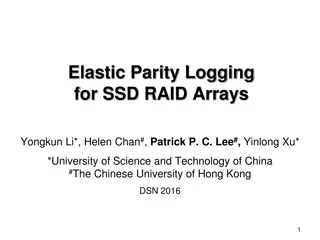Evolution of Indian-White Relations: Raid or Trade?
The article discusses how Indian-White relations transitioned from cooperation to conflict over time, exploring the factors influencing negotiation outcomes versus violent confrontations. The model presented highlights the role of property rights, informational asymmetry, military technology, and the presence of standing armies in shaping conflict resolution dynamics and the likelihood of trade. Importance of well-defined property rights and political incentives in determining the choice between raiding or trading is emphasized.
Download Presentation

Please find below an Image/Link to download the presentation.
The content on the website is provided AS IS for your information and personal use only. It may not be sold, licensed, or shared on other websites without obtaining consent from the author.If you encounter any issues during the download, it is possible that the publisher has removed the file from their server.
You are allowed to download the files provided on this website for personal or commercial use, subject to the condition that they are used lawfully. All files are the property of their respective owners.
The content on the website is provided AS IS for your information and personal use only. It may not be sold, licensed, or shared on other websites without obtaining consent from the author.
E N D
Presentation Transcript
RAID OR TRADE? AN ECONOMIC MODEL OF INDIAN-WHITE RELATIONS TERRY ANDERSON & FRED MCCHESNEY
OVERVIEW "The first Pilgrim Thanksgiving owed much, if not all, to peaceful, mutually beneficial relations with the Indians. But Custer's Last Stand, Chief Joseph's attempted escape to Canada, and, finally, wounded Knee how relations deteriorated from cooperation to conflict as whites increasingly moved into Indian territory. "This article presents theory and evidence that [Indian and white] relations evolved over time from an era of relative peace, including contracts for property rights (treaties), to an era of violent takings."
THE MODEL OF RAIDING VS. TRADING PRESENTED HERE YIELDS FIVE MAIN HYPOTHESIS: 1. Zone of Controversy Within the zone of controversy, negotiated outcomes will dominate violent ones as long as certain conditions hold 2. Informational Asymmetry Most disputes will degenerate into violence, ceteris paribus, when the two sides differ about expected outcomes of fighting. 3. Military Technology New weapons may cause hostilities if the other side is not well informed about their impact 4. Property Rights For trade to occur, property rights must be well specified and divestible, and agreements enforceable. Otherwise, increased transaction costs will reduce the surplus from negotiation and increase the likelihood of conflict. 5. Standing Army vs. Militia A standing army lowers the incremental costs of assembling fighting coalitions, decreasing the marginal costs of war and shrinking the surplus from negotiation. These rise of a standing army also creates political incentives that increase the likelihood of fighting to resolve disputes.
CONCLUSIONS: "This episode demonstrates the importance of property rights. If two demanders of a resource have well-defined systems of divestible and enforceable rights, negotiation costs are lower and trade more likely. When such a common set of property rights is lacking, however, the potential for peaceful negotiations declines." "Finally, the Indians wars show the important role of politics in collective decisions to raid or trade. Particularly with the substitution of a standing army for local militias, war rather than negotiation became useful for politically potent group sin the United States."























